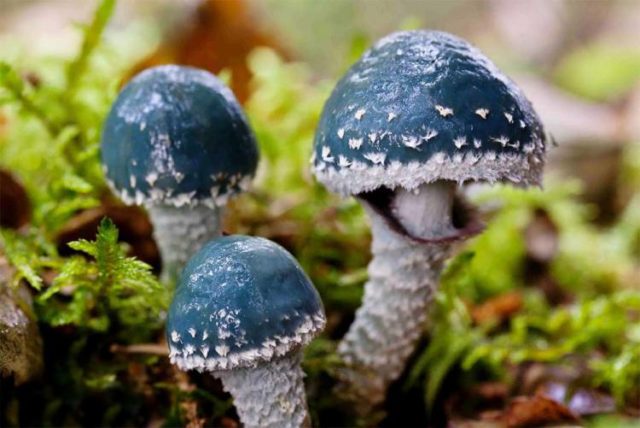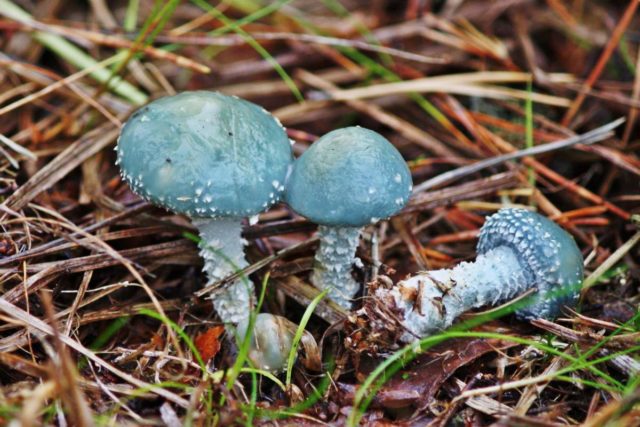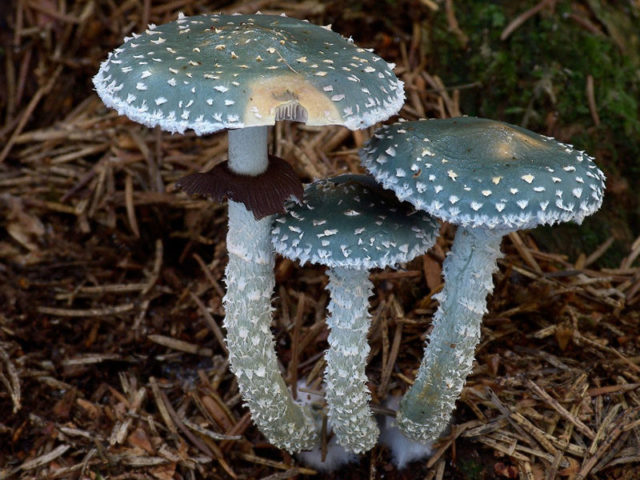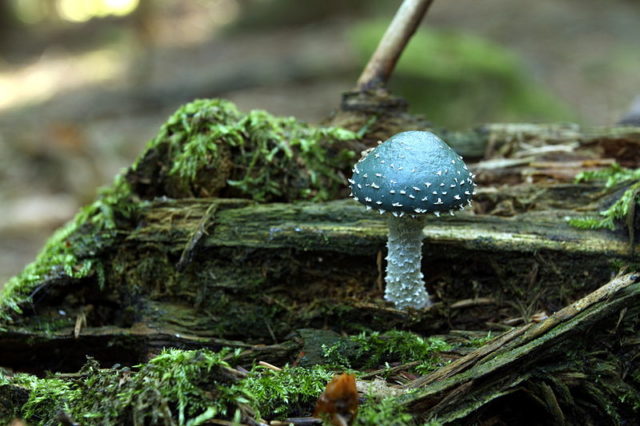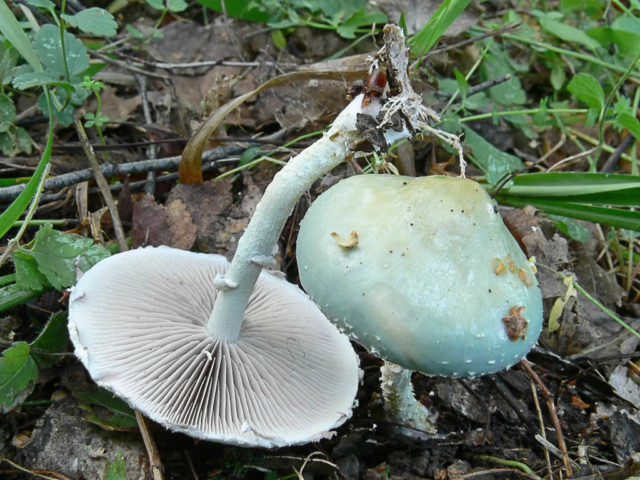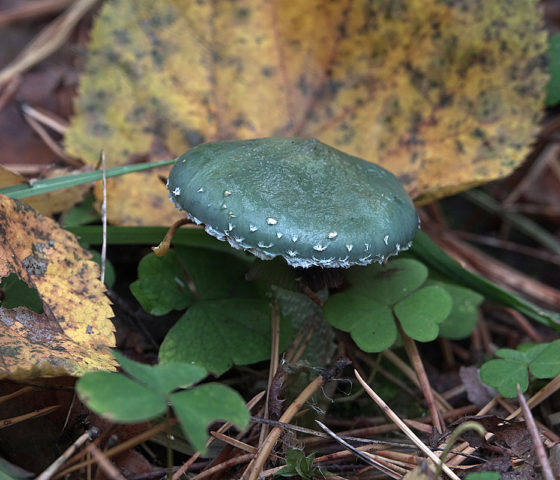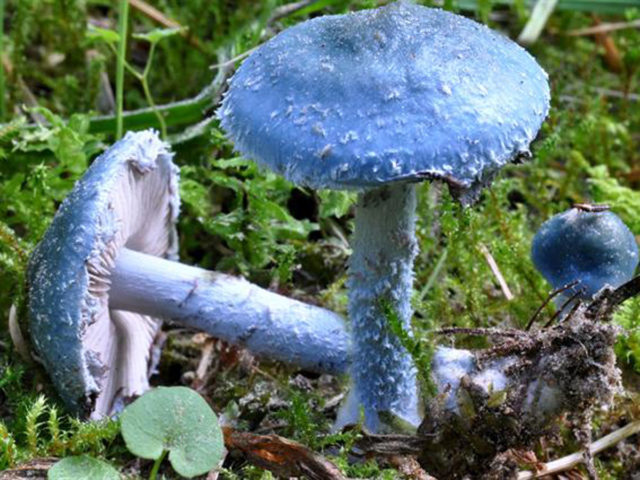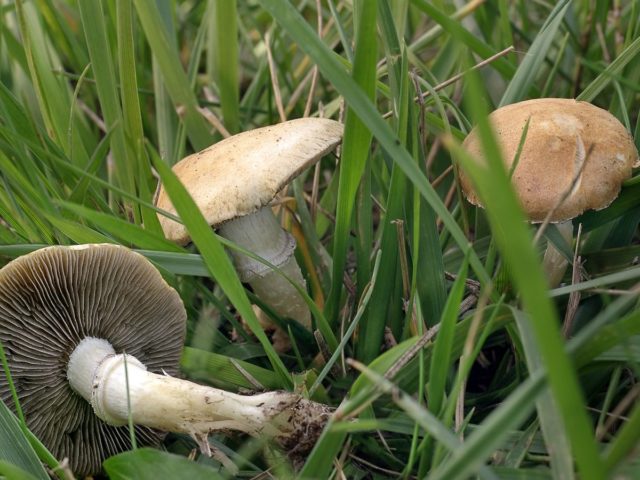Content
Stropharia blue-green is an interesting mushroom with mild poisonous properties, which, nevertheless, is allowed to be eaten. For stropharia to be safe, it is important to be able to distinguish it from similar species and to prepare it correctly.
Description of stropharia blue-green
Photos and descriptions of blue-green stropharia help you easily recognize it in the forest. Also called Copper Trochling Yar, the mushroom has a distinctive appearance and vibrant color.
Description of the hat
The troyshling's hat is wide-conical in shape, reaches from 3 to 12 cm in diameter. In the photo of the blue-green stropharia mushroom, it can be seen that in young fruit bodies the shade of the cap is closer to bluish-green, and the skin is covered with a slimy film. As it grows older, the cap dries up, yellow and brownish spots appear on it.
You can recognize young mushrooms by a clear tubercle in the center of the cap and by the remains of a blanket at the edges. The plates on the cap are gray-green in color; with age they acquire a dark brown or even lilac hue, and the edges of the hymenophore remain white.
Leg description
The leg of the blue-green stropharia reaches 12 cm in height and 2 cm in girth. The structure is slippery, scaly or hairy, sometimes with a preserved ring. In color, the leg is pale greenish or pale bluish, almost the same shade as the cap.
Where and how it grows
You can usually meet blue-green stropharia on the wood of dead trees, on stumps and fallen trunks, on spruce, pine and fir wood, less often it grows on deciduous trees. The fungus is common in all areas with a temperate climate, appears mainly closer to autumn - from late August to mid-October. You can meet him in the Moscow region and in Siberia, in the Far East and in the southern regions.
Usually, the troyshling yarrow grows in groups or in dense bunches, it is rare to see single fruiting bodies.
Is the blue-green stropharia edible or not
Various sources have their own opinions regarding the edibility of this variety. The pulp contains a dangerous acid with a narcotic effect, which is part of the opium. Overall, however, the mushroom is considered edible, albeit mildly poisonous, with hallucinogenic properties.
It is impossible to use Copper Yar troyshling in its raw form, it will harm your health. However, after boiling, the main part of the hazardous substances from the pulp leaves, and the stropharia becomes suitable for food use.
How to cook blue-green stropharia
Weakly poisonous and hallucinogenic mushroom stropharia blue-green needs especially careful processing before eating. If you neglect the preparation, then not only food poisoning will occur, but also severe mental consequences. A large amount of troyshling eaten can have the same effect on the body as a strong drug with a hallucinogenic effect.
Mushroom preparation
When processing blue-green fruit bodies, it is important to remove the thin skin from the caps, it is in it that the concentration of harmful substances is highest. The peel is peeled off easily, in much the same way as with butter.
Peeled fruit bodies must be placed in a deep saucepan with salted water and boiled for at least 15 minutes. After that, the caps are thrown back in a colander, and the broth is drained - it is unsuitable for use in food.
How to pickle blue-green stropharia
A properly peeled and boiled mushroom is suitable for further pickling. The recipe for marinating troschling is as follows:
- water and 100 ml of table vinegar are poured into a deep saucepan;
- add 1 large spoonful of salt and bring the water to a boil;
- 1 kg of prepared stropharias are placed in the solution.
When the fruit bodies let out the juice, and foam appears on the surface of the water, it will need to be removed. Stropharia are boiled in water and vinegar for 15 minutes, then 1 small spoonful of sugar, a few peas of allspice, a little clove and cinnamon are placed in the marinade. You can also add bay leaves or star anise to taste.
The marinade is boiled for another 10 minutes, and then removed from the stove and poured hot into sterilized jars. After the blanks have cooled down under a warm blanket, they can be stored in the refrigerator for further storage.
Salting stropharia blue-green
The description of the use of blue-green stropharia suggests another recipe - cold salting of troyshling.
For cooking you will need:
- cut the large caps of the boiled mushrooms into small pieces, and leave the small ones intact;
- put the stropharia in a jar in layers of 6-10 cm, alternating each of the layers with a lot of salt;
- along with salt, add garlic and other aromatic spices to taste to the preparation;
- alternate salt and mushrooms until the jar is full.
After that, the neck of the container is closed with thick gauze and a heavy load is placed on top. After a couple of days, the stropharias in the jar will be plentifully letting in juice, and in total it will take 30-40 days for salting. During this time, the gauze on the neck of the jar will need to be changed regularly so that mold does not appear on it.
Limitations and contraindications
Since the blue-green Stropharia Aeruginosa has a hallucinogenic effect on the body, it should be consumed in very small quantities even after careful processing. In case of an overdose of troshlings, nervous overexcitation is observed, hallucinations occur - visions that can last for several hours in time. In general, the effect of blue-green stropharia on the body in case of an overdose is similar to the effect of the drug LSD and leads to paranoia, delirium, anxiety and euphoria.
It is forbidden to use troyshling on an empty stomach or in a weakened state, in which case the toxins will have a stronger effect. The mushroom is absolutely contraindicated for people suffering from mental disorders, it is absolutely forbidden to use it for women in position, young children and adolescents until adulthood.
Also, blue-green stropharia has contraindications that are quite typical for mushrooms.It is better not to eat it with sluggish digestion and a tendency to constipation, since the mushroom pulp is absorbed with difficulty. It is better to refuse the product in case of exacerbation of chronic gastric diseases.
Doubles and their differences
Despite the recognizable appearance and photo of the blue-green stropharia, it can be confused with some other mushrooms. The twins of the troschling are mostly conditionally edible, suitable for food use after processing.
Sky blue stropharia
Mushrooms belong to the same genus and therefore are similar to each other. But the sky blue stropharia has a richer blue hue with small ocher spots. In addition, the hat in the blue variety is usually flattened in adulthood, while in the blue-green variety it often retains a conical shape.
Unlike troshling, blue stropharia does not grow on dead tree wood, but in parks and pastures, on roadsides and in other places with fertile soil. The mushroom is considered edible, however, due to its unusual appearance, it is rarely used in cooking.
Crowned stropharia
This variety is very similar to blue-green in size and shape, the crown of the crown type is also conical, with scraps of bedspreads along the edges. But you can distinguish the species by color - the crown stropharia has a yellowish, ocher, beige or lemon tint.
It is not accepted to eat the mushroom, it is little studied, and various sources attribute it to conditionally edible or unambiguously poisonous.
Interesting facts about blue-green stropharia
Unusual troyshling copperhead yar looks very beautiful, however, due to its shape and color, it is perceived by mushroom pickers with caution. Although the harmful properties of troschling are reduced when processed correctly, most people avoid using it in food.
Other interesting facts are associated with blue-green stropharia:
- Even in antiquity, troyshling and similar types were used for religious rituals - hallucinogenic properties helped priests and shamans enter a state of special ecstasy.
- Currently, information about the edibility of stropharia varies from country to country. In Europe, it is simply considered tasteless, but in America it is classified as a poisonous category.
It is curious that a large number of dead insects in a semi-decomposed state can often be seen on the slimy cap of the troyshling. There is a version that the mucus on the cap promotes the digestion of the bodies of flies and mosquitoes, but so far this has not been proven for sure.
Conclusion
Stropharia blue-green is an approved but potentially dangerous mushroom. Before using it for food, it must be carefully processed in order to neutralize the possible harm.
